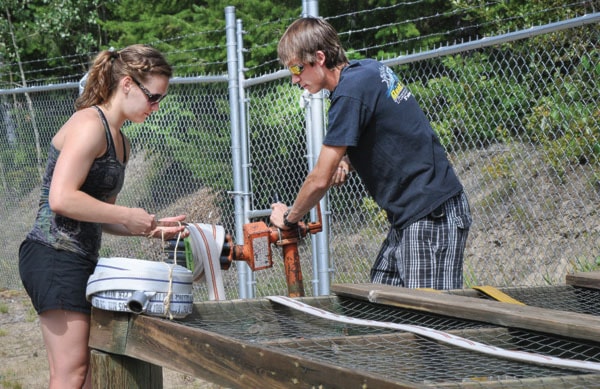The Salmon Arm Fire Zone has issued a call to high school students for its Junior Rapattack program.
Every year, two local grade 11 or 12 students learn the ropes along with regular rapattackers in a program that has enormous benefits to both parties.
While tryouts for the program that provides students with excellent training and a well-paying summer job aren’t until April, fire protection assistant Brady Holliday is hoping to spark interest now.
The Junior Rapattack program has been running locally since 1998 and currently there are eight members of regular rapattack crews who participated in the junior program.
“Over the years a number of people who have worked through the program have stayed multiple years and some have gone on to other jobs throughout the province,” Holliday says. “So for us, It’s a really good recruiting tool. They stay around.”
Holliday was pleased with the 2013 juniors – Lucy Grainger and Thomas Hardy.
“They were really valuable, we had them paired up with initial attack crews and they just worked as if they were hired,” he says. “Each of them had 20 days on fires. We had them out the whole time and they were very hard workers.”
Grainger, who graduated from Salmon Arm Secondary this year, highly recommends the experience.
“If you’re looking for something that’s physically demanding and just a lot of fun, this is it, but you’ve gotta push yourself,” says the young athlete who competed in the 2013 Canadian Judo Championships. “Oftentimes you think you couldn’t do this and you do. It’s awesome.”
Grainger admits the physical training is challenging, with 90 minutes of fitness sessions held at the end of every day.
“You slowly get better, it’s really good,” she says of the early challenges. “The atmosphere is really nice too. They’re really genuine people.”
Holliday agrees that the ability to be part of the team is as important as meeting the national fitness standard for firefighters.
Junior rap attackers are integrated into team rotation right away – cleaning, tool maintenance, training with pumps and becoming familiar with procedures.
“There’s not a lot of official training, we rely a lot on on-the-job-training,” says Holliday, noting juniors only attend fires in the Salmon Arm Fire Zone. “Juniors work directly under the crew leader and senior firefighters.”
Grainger agrees, pointing out that even as a junior, everyone is expected to watch out for other people, something, she says is definitely reflected on the rapattack base.
Grainger worked on 11 wildfires, first seeing action early in August following a lightning strike near Seymour Arm.
The crew drove out and stayed overnight, she says, noting there was a short hike up to the fire.
“There was a creek nearby and we hosed her down and put in a guard on the foot-and-a-half spot fire,” she says. “It was exciting. In movies you see these huge fires, but it was not like that. It was odd walking into it and seeing fire on the forest floor.”
Like everyone else who wishes to be part of the rapattack team, Grainger will have to re-apply for a position.
“I’d definitely go for it, it’s probably one of the best summer jobs I had,” she says. “It’s definitely different and helicopters are fun.”
Students who would like to have some of those experiences should attend an open house at Salmon Arm Secondary in April.
Keep in mind, students who are selected for the program have to maintain good physical and academic levels.
After the presentation, students submit a resume, with interviews following mid to end of April.
Fifiteen students are selected for initial training that is held over four weeks in May and June – up to three days per week after school from 4 to 7 p.m. and one weekend camping trip where students undertake some field exercises, survival training and basic firefighting.
“At the end they get S100 - basis firefighting training and they would be able to work as emergency firefighters with contract crews in some kind of capacity,” says Holliday. “Two people are selected for a full-time job from the beginning of July to the end of August.”
